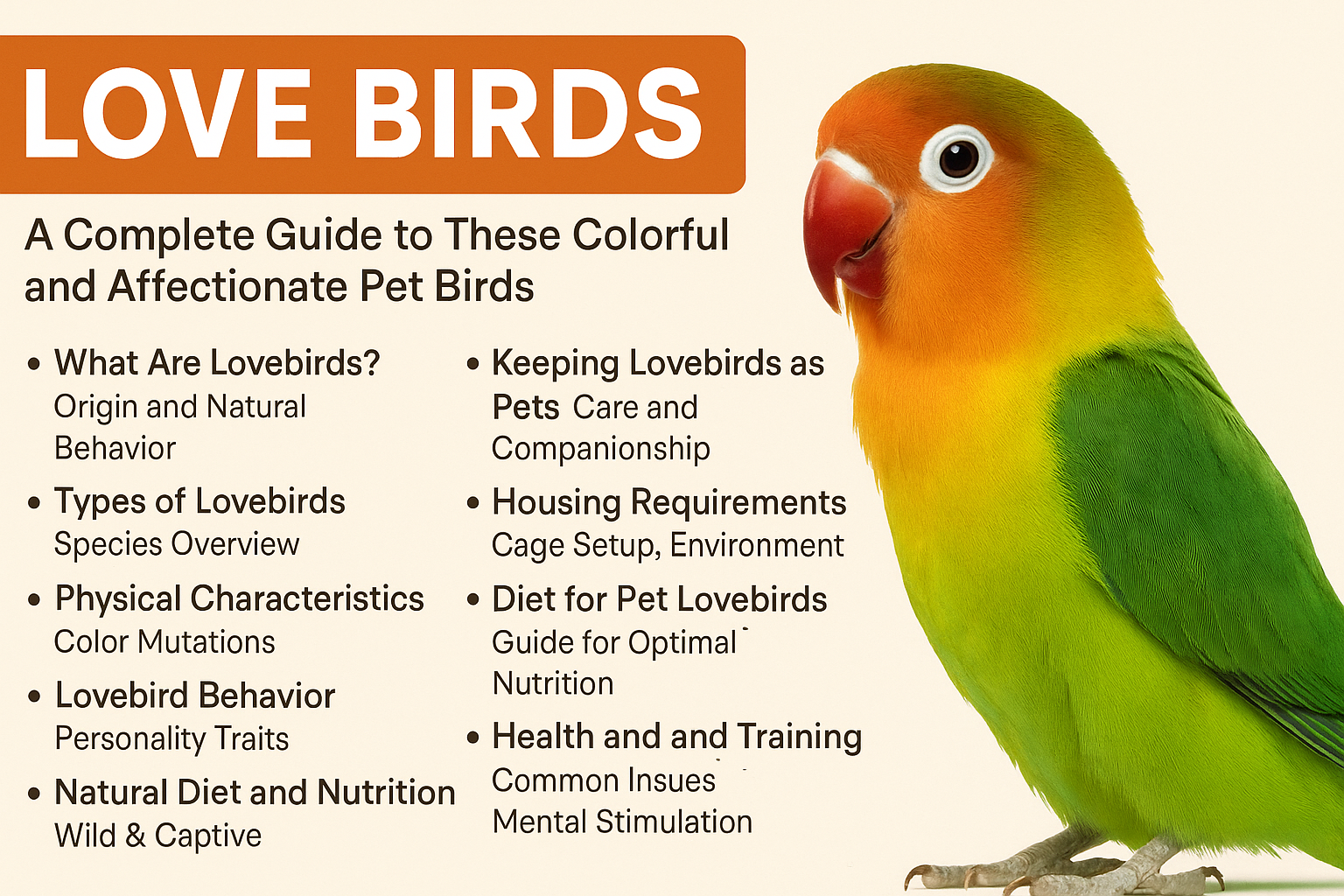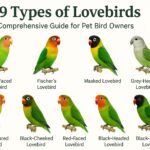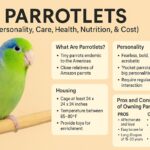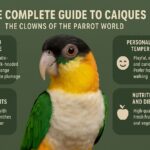Lovebirds are small, vibrant parrots known for forming strong bonds with their partners and for their engaging personalities as pets. These colorful birds have captured the hearts of bird enthusiasts worldwide through their charming behaviors and relatively manageable care requirements.
This article explores everything from their natural history and species diversity to proper care practices and health considerations for those interested in keeping these charismatic birds as companions.
Lovebird‘s History, Appearance, and Personality
Lovebirds belong to the genus Agapornis, which combines the Greek words “agape” meaning love and “ornis” meaning bird, perfectly capturing their reputation for strong pair bonding. They are small parrots native to the African continent, with one species (the grey-headed lovebird) originating from Madagascar. In their natural habitat, these social birds live in small flocks, consuming a varied diet of fruits, vegetables, grasses, and seeds.
These birds range from 13-17 cm (5-7 inches) in length with a wingspan up to 24 cm and typically weigh between 40-60 grams (1.5-2 ounces). Their compact build, short, blunt tails, and relatively large, sharp beaks are distinctive physical characteristics that help identify them among other small parrots.
The strong monogamous pair bonds formed by lovebirds in the wild gave rise to their romantic name, as paired birds spend considerable time sitting close together, often engaging in mutual preening behaviors. This affectionate behavior has contributed to their popularity as pets, with several species successfully bred in captivity for the pet trade.
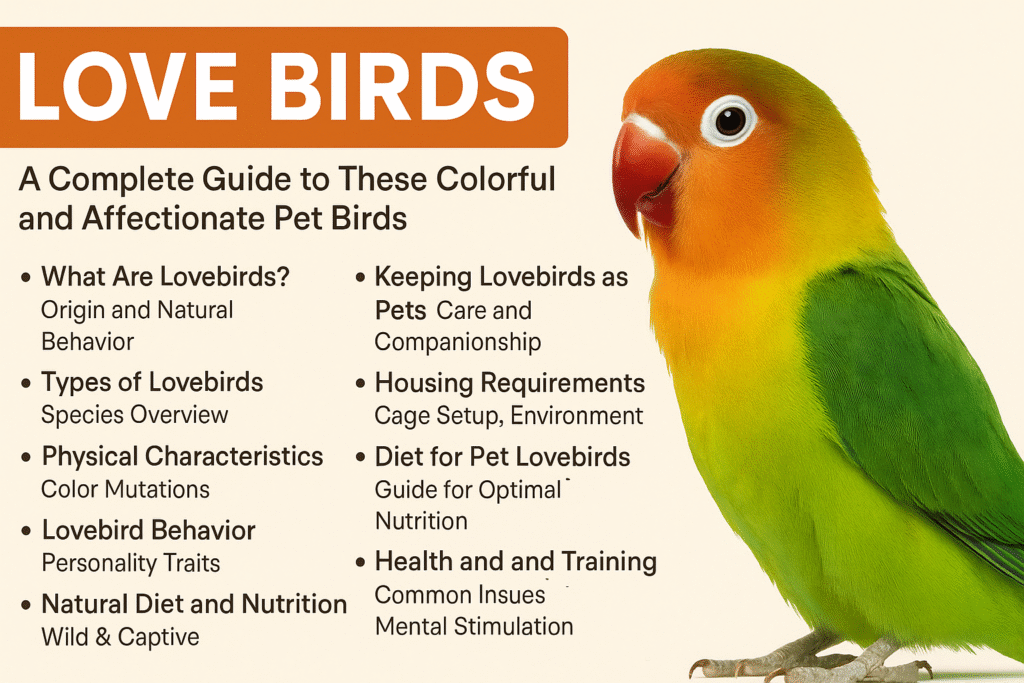
Species of Lovebirds
There are nine distinct species of lovebirds in the Agapornis genus, though not all are suitable or available as pets. The three most popular lovebird species kept as companions include:
- Rosy-faced/Peach-faced Lovebird (Agapornis roseicollis): Named for their peach-colored heads, these birds are typically green with blue rumps in their wild form. They measure about 15cm (5.9 inches) long and have gray feet and horn-colored bills. Due to selective breeding, they now appear in numerous color variations, making them particularly popular among bird enthusiasts. This species is often easier to tame compared to other lovebird types. Two subspecies exist: A. roseicollis catumbella (Angola) and A. roseicollis roseicollis (Namibia, Botswana, and South Africa).
- Yellow-collared/Masked Lovebird (Agapornis personatus): This species has several common names all referencing its distinctive dark or black head, yellow collar, and predominantly green body. They feature characteristic white rings around their eyes, reddish beaks, and gray feet, measuring around 14.5cm (6 inches). Various color mutations exist, including blue (which occurs naturally in wild populations), violet, and mauve variants. Masked lovebirds are known for being relatively vocal compared to other species.
- Fischer’s Lovebird (Agapornis fischeri): One of the smaller lovebird species at 14-15cm (5.5-5.9 inches), Fischer’s lovebirds are distinctive and popular as pets.
Other species include the black-collared lovebird, which serves as the type species for the genus, and the grey-headed lovebird from Madagascar.
Physical Characteristics
Wild lovebirds typically display predominantly green plumage with varied coloration on their upper bodies depending on the species. Through selective breeding in captivity, bird enthusiasts have developed approximately 30 different plumage color variations caused by special pigments called psittacofulvins.
Several species, including Fischer’s lovebird, black-cheeked lovebird, and masked lovebird, feature prominent white rings around their eyes, giving them a distinctive appearance. Their stocky build and relatively large beaks compared to their body size are characteristic features of all lovebird species.
Males and females typically look identical in most lovebird species, making visual sex determination challenging without genetic testing. This similarity extends across most physical features, including size, coloration, and general appearance.
The variety of color mutations available in captive-bred birds has significantly contributed to their popularity as pets. These color variations range from subtle differences in tone to dramatic changes in overall appearance, allowing bird keepers to select companions with unique and attractive coloration.
Behavior and Social Nature
The name “lovebird” originates from these birds’ strong monogamous pair bonding and the extended periods paired birds spend sitting together. This behavior is most obvious when observing pairs who often engage in mutual preening and remain physically close to each other throughout the day.
In their natural environment, lovebirds are highly social creatures that live in small flocks. This social structure influences their behavior both in the wild and in captivity. When feeding on fruits and other foods in nature, lovebirds typically gather in large social groups, displaying their communal tendencies.
While not particularly known for talking or mimicking sounds like some larger parrots, lovebirds still communicate through various vocalizations, including singing, whistling, and chirping5. Birds kept in pairs or small groups tend to vocalize more frequently than solitary birds, as they use these sounds to communicate with each other.
Their intelligent and active nature means they require regular interaction and mental stimulation. Without adequate attention and activities, lovebirds may develop problematic behaviors such as feather plucking. Single lovebirds can form strong bonds with their human caregivers when properly socialized, though most experts recommend keeping them in pairs to satisfy their natural social needs.
Natural Diet and Nutrition
In their native habitats across Africa, lovebirds maintain a varied diet that contributes to their overall health and well-being. They are primarily herbivorous, with plant-based foods forming the foundation of their natural diet. Their feeding habits include consuming fruits, vegetables, seeds, nuts, and other plant materials like buds and leaves. Some species also incorporate insects into their diet, making them technically omnivorous.
The dietary flexibility varies among lovebird species. Some can adapt to a wide range of food types, while others depend on specific foods such as figs. Their opportunistic nature allows them to consume seasonally available fruits and grasses in their environment.
When feeding, lovebirds demonstrate their social tendencies by eating in large groups. This communal behavior reinforces flock bonds and provides safety through collective vigilance against predators.
Some lovebird species, particularly the Rosy-faced lovebird, have gained reputation as agricultural pests in certain African regions due to their habit of raiding farmers’ fields for grains like millet and maize. Their voracious appetite for these crops has occasionally created tension between wildlife conservation efforts and agricultural interests.
The natural diet of wild lovebirds provides important insights for pet owners seeking to replicate appropriate nutrition in captivity. A balanced diet supporting both physical health and emotional well-being should include elements similar to what these birds would naturally consume.
Lovebirds as Pets
Keeping lovebirds as companions requires understanding their specific needs and making a substantial time commitment. With proper care, these birds can live 15 years or more, while some sources suggest 15-20 years is possible. This longevity means potential owners should carefully consider their ability to provide decades of appropriate care.
Although lovebirds are famous for pair bonding, single birds can make wonderful pets when given sufficient human interaction. A solitary lovebird often forms a strong bond with its human caregiver, especially when socialized from a young age. However, without regular attention and playtime outside their cage, single birds may develop behavioral issues.
For those unable to provide constant companionship, keeping lovebirds in pairs is recommended. When housed together, these birds entertain each other and engage in natural social behaviors. Their characteristic pair bonding-where birds spend significant time preening each other and staying physically close-is most obvious when observing bonded pairs.
While not renowned for talking abilities like larger parrots, lovebirds communicate through various vocalizations including singing, whistling, and chirping. Their personality tends toward being active, curious, and playful, requiring regular mental stimulation to prevent boredom and associated problematic behaviors.
Housing Requirements
Creating an appropriate living environment is essential for lovebird health and happiness. The minimum recommended cage size for a single lovebird is 18″ L x 18″ W x 24″ H, while a pair requires at least 24″ L x 18″ W x 24″ H. Wire-based habitats are preferred as they provide better ventilation and opportunities for climbing.
Lovebirds thrive in average household temperatures between 65°F and 80°F. Owners should protect their birds from extreme temperature fluctuations, drafts, and direct exposure to air conditioning or heating vents, which can cause stress or illness.
The cage should include multiple perches of varying diameters and textures to promote foot health and prevent podiatric issues. Natural wood perches often work best as they provide appropriate texture and can be occasionally chewed by the birds.
Essential cage furnishings include food and water dishes, a cuttlebone holder, and paper-based cage liner for easy cleaning. Toys are vital for mental stimulation-a variety of chewable, manipulative, and interactive toys should be provided and rotated regularly to maintain interest and prevent boredom.
Positioning the cage matters as well-place it in a room where the bird can observe family activities without being directly in high-traffic areas or kitchen spaces where cooking fumes might pose health risks. Avoid locations near windows with direct sunlight that could cause overheating or near drafty areas.
Diet for Pet Lovebirds
A nutritionally complete diet for pet lovebirds combines commercial bird foods with fresh produce to mimic their natural eating habits. High-quality pelleted food designed specifically for lovebirds should form the foundation of their diet. These pellets provide consistent nutrition and help prevent selective eating behaviors common when offering seed-only diets.
While some seeds can be included, particularly as treats or training rewards, an exclusively seed-based diet lacks essential nutrients and can lead to health problems. Millet spray serves as an excellent occasional treat and can be offered in a holder designed for this purpose.
Fresh fruits and vegetables should comprise approximately 20-30% of a pet lovebird’s diet. Safe options include apples, bananas, berries, carrots, leafy greens, and bell peppers. Certain foods, including avocado, chocolate, caffeine, alcohol, and high-salt or high-fat foods, must be avoided as they can be toxic or harmful to birds.
Fresh, clean water must be available at all times, changed daily or more frequently if contaminated. Some lovebirds enjoy bathing, which supports feather health and natural grooming behaviors. A shallow bird bath within their cage or a gentle misting with room-temperature water using a spray bottle provides opportunities for bathing.
Mineral supplements like cuttlebones and mineral cakes support calcium intake and beak maintenance. These should be secured in the cage using appropriate holders and replaced when substantially worn down.
Health and Wellness
Maintaining optimal health for lovebirds requires understanding common health issues and implementing preventative care practices. Regular observation for signs of illness allows for early intervention when problems arise.
Signs of illness in lovebirds include listlessness, fluffed-up feathers, wheezing, changes in droppings, weight loss, decreased appetite, unusual posture, or changes in behavior. Respiratory infections present as wheezing with fluffed feathers, requiring immediate veterinary attention while keeping the bird warm.
Parasitic infections, such as mites, can cause itching, weight loss, and feather loss. Treatment typically involves appropriate sprays recommended by veterinarians or pet stores experienced with bird care.
Digestive issues often manifest as wet droppings, potentially resulting from contaminated food, dietary changes, or insufficient fresh water. Initial home care includes keeping the bird warm and ensuring clean water access, but veterinary consultation remains important if problems persist.
Feather plucking indicates possible dietary deficiencies, insufficient exercise, or inadequate mental stimulation. Addressing this behavior requires increasing interaction time, providing appropriate toys, and possibly consulting an avian veterinarian if the behavior continues.
Regular nail and beak maintenance prevents overgrowth issues. Iodine blocks can help birds naturally maintain beak condition through normal use. Excessively long nails or beaks require expert attention to prevent injury or discomfort.
Finding a veterinarian with specific experience treating birds is crucial for proper medical care. Regular check-ups with an avian specialist can identify potential health issues before they become serious problems.
Enrichment and Training
Lovebirds possess intelligence and curiosity, requiring regular mental stimulation through appropriate enrichment activities. Daily playtime outside their enclosure provides essential exercise and environmental variety. A separate play gym in a bird-safe room gives them the opportunity to explore while remaining protected from household hazards.
A variety of toys should be provided and rotated regularly to maintain interest. Appropriate toys include those designed for chewing, manipulating, puzzle-solving, and making noise. Natural materials like untreated wood, paper, and safe plant fibers make excellent destroying toys that satisfy natural chewing instincts.
Training exercises using positive reinforcement techniques provide mental stimulation while strengthening the bond between the bird and the caregiver. Simple target training, step-up commands, and basic tricks can be taught through patience and consistent reward-based methods. Even lovebirds, not known for extensive vocal mimicry, can learn basic behaviors through proper training approaches.
Social interaction represents one of the most important forms of enrichment for these naturally social birds. Whether interaction comes from another bird companion or from human family members, regular social contact prevents boredom and associated behavioral problems.
Conclusion
Lovebirds offer a combination of vibrant beauty, engaging personality, and manageable size that makes them popular companion birds for those prepared to meet their specific needs. Understanding their natural behaviors, dietary requirements, and environmental needs allows owners to provide proper care throughout their potentially lengthy lifespan.
Whether kept singly with substantial human interaction or in compatible pairs that display their famous bonding behaviors, these colorful parrots bring energy and character to their human families. Their care requires commitment to appropriate housing, nutrition, enrichment, and health maintenance, but rewards owners with the companionship of these charismatic birds.
For those considering adding lovebirds to their family, researching specific species characteristics and consulting with avian specialists helps ensure a successful relationship with these fascinating members of the parrot family.
With proper attention to their physical and psychological needs, lovebirds can thrive as pets while displaying the natural behaviors that earned them their romantic name.
- 9 Types of Lovebirds (A Comprehensive Guide for Pet Bird Owners) - June 20, 2025
- Labrador Retriever: America’s Most Beloved Family Dog - June 9, 2025
- The Complete Guide to Indian Ringneck Parrots - June 9, 2025
